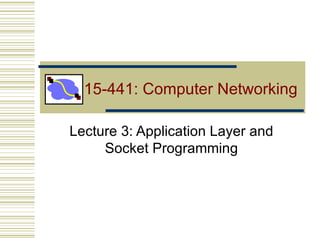
Application Layer and Socket Programming
- 1. 15-441: Computer Networking Lecture 3: Application Layer and Socket Programming
- 9. Transport Service Requirements of Common Apps no loss no loss no loss loss-tolerant loss-tolerant loss-tolerant no loss elastic elastic elastic audio: 5Kb-1Mb video:10Kb-5Mb same as above few Kbps elastic no no no yes, 100’s msec yes, few secs yes, 100’s msec yes and no file transfer e-mail web documents real-time audio/ video stored audio/video interactive games financial apps Application Data loss Bandwidth Time Sensitive
- 11. Server and Client TCP/UDP IP Ethernet Adapter Server TCP/UDP IP Ethernet Adapter Clients Server and Client exchange messages over the network through a common Socket API Socket API hardware kernel space user space ports
- 14. Network Addressing Analogy 412-268-8000 ext.123 Central Number Applications/Servers Web Port 80 Mail Port 25 Exchange Area Code 412-268-8000 ext.654 IP Address Network No. Host Number Telephone No 15-441 Students Clients Professors at CMU Network Programming Telephone Call Port No. Extension
- 34. Review: TCP Client-Server Interaction socket() bind() listen() accept() write() read() read() TCP Server close() socket() TCP Client connect() write() read() close() connection establishment data request data reply end-of-file notification from UNIX Network Programming Volume 1, figure 4.1
- 42. Review: UDP Client-Server Interaction socket() bind() recvfrom() sendto() UDP Server socket() UDP Client sendto() recvfrom() close() blocks until datagram received from a client data request data reply from UNIX Network Programming Volume 1, figure 8.1
- 48. TCP IP Ethernet Adapter Web Server Port 80 How can a a web server manage multiple connections simultaneously? Port 8001 More Details About a Web Server
- 50. A Few Programming Notes: Representing Packets 0 1 2 3 0 1 2 3 4 5 6 7 8 9 0 1 2 3 4 5 6 7 8 9 0 1 2 3 4 5 6 7 8 9 0 1 +-+-+-+-+-+-+-+-+-+-+-+-+-+-+-+-+-+-+-+-+-+-+-+-+-+-+-+-+-+-+-+-+ | Type | +-+-+-+-+-+-+-+-+-+-+-+-+-+-+-+-+-+-+-+-+-+-+-+-+-+-+-+-+-+-+-+-+ | Length | Checksum | +-+-+-+-+-+-+-+-+-+-+-+-+-+-+-+-+-+-+-+-+-+-+-+-+-+-+-+-+-+-+-+-+ | Address | +-+-+-+-+-+-+-+-+-+-+-+-+-+-+-+-+-+-+-+-+-+-+-+-+-+-+-+-+-+-+-+-+ Type: 4-byte integer Length: 2-byte integer Checksum: 2-byte integer Address: 4-byte IP address
- 51. A Few Programming Notes: Building a Packet in a Buffer struct packet { u_int32_t type; u_int16_t length; u_int16_t checksum; u_int32_t address; }; /* ================================================== */ char buf[1024]; struct packet *pkt; pkt = (struct packet*) buf; pkt->type = htonl (1); pkt->length = htons (2); pkt->checksum = htons (3); pkt->address = htonl (4);
